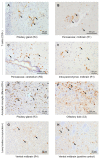Brain Inflammation and Intracellular α-Synuclein Aggregates in Macaques after SARS-CoV-2 Infection
- PMID: 35458506
- PMCID: PMC9025893
- DOI: 10.3390/v14040776
Brain Inflammation and Intracellular α-Synuclein Aggregates in Macaques after SARS-CoV-2 Infection
Abstract
SARS-CoV-2 causes acute respiratory disease, but many patients also experience neurological complications. Neuropathological changes with pronounced neuroinflammation have been described in individuals after lethal COVID-19, as well as in the CSF of hospitalized patients with neurological complications. To assess whether neuropathological changes can occur after a SARS-CoV-2 infection, leading to mild-to-moderate disease, we investigated the brains of four rhesus and four cynomolgus macaques after pulmonary disease and without overt clinical symptoms. Postmortem analysis demonstrated the infiltration of T-cells and activated microglia in the parenchyma of all infected animals, even in the absence of viral antigen or RNA. Moreover, intracellular α-synuclein aggregates were found in the brains of both macaque species. The heterogeneity of these manifestations in the brains indicates the virus' neuropathological potential and should be considered a warning for long-term health risks, following SARS-CoV-2 infection.
Keywords: COVID-19; SARS-CoV-2; macaques; neuroinflammation; positron emission tomography-computed tomography; α-synuclein.
Conflict of interest statement
The authors declare no conflict of interest.
Figures




Similar articles
-
Longitudinal positron emission tomography and postmortem analysis reveals widespread neuroinflammation in SARS-CoV-2 infected rhesus macaques.J Neuroinflammation. 2023 Jul 29;20(1):179. doi: 10.1186/s12974-023-02857-z. J Neuroinflammation. 2023. PMID: 37516868 Free PMC article.
-
The Post-Acute Phase of SARS-CoV-2 Infection in Two Macaque Species Is Associated with Signs of Ongoing Virus Replication and Pathology in Pulmonary and Extrapulmonary Tissues.Viruses. 2021 Aug 23;13(8):1673. doi: 10.3390/v13081673. Viruses. 2021. PMID: 34452537 Free PMC article.
-
Modeling SARS-CoV-2: Comparative Pathology in Rhesus Macaque and Golden Syrian Hamster Models.Toxicol Pathol. 2022 Apr;50(3):280-293. doi: 10.1177/01926233211072767. Epub 2022 Feb 5. Toxicol Pathol. 2022. PMID: 35128980 Free PMC article.
-
Dopamine Transmission Imbalance in Neuroinflammation: Perspectives on Long-Term COVID-19.Int J Mol Sci. 2023 Mar 15;24(6):5618. doi: 10.3390/ijms24065618. Int J Mol Sci. 2023. PMID: 36982693 Free PMC article. Review.
-
Exploring the Paradox of COVID-19 in Neurological Complications with Emphasis on Parkinson's and Alzheimer's Disease.Oxid Med Cell Longev. 2022 Aug 31;2022:3012778. doi: 10.1155/2022/3012778. eCollection 2022. Oxid Med Cell Longev. 2022. PMID: 36092161 Free PMC article. Review.
Cited by
-
Gut-brain pathogenesis of post-acute COVID-19 neurocognitive symptoms.Front Neurosci. 2023 Sep 28;17:1232480. doi: 10.3389/fnins.2023.1232480. eCollection 2023. Front Neurosci. 2023. PMID: 37841680 Free PMC article.
-
Prolonged fecal shedding of replication-competent virus, lasting immune activation, and intestinal inflammation in a rhesus macaque after experimental SARS-CoV-2 infection.Front Cell Infect Microbiol. 2024 Dec 18;14:1505720. doi: 10.3389/fcimb.2024.1505720. eCollection 2024. Front Cell Infect Microbiol. 2024. PMID: 39744155 Free PMC article.
-
Sowing SARS-CoV-2 to reap neurodegeneration: A hamster study.EBioMedicine. 2022 Jun;80:104071. doi: 10.1016/j.ebiom.2022.104071. Epub 2022 May 25. EBioMedicine. 2022. PMID: 35633617 Free PMC article. No abstract available.
-
COVID-19 Alters Inflammatory, Mitochondrial, and Protein Clearance Pathway Genes: Potential Implications for New-onset Parkinsonism in Patients.J Neuroimmune Pharmacol. 2025 May 22;20(1):58. doi: 10.1007/s11481-025-10215-4. J Neuroimmune Pharmacol. 2025. PMID: 40404934 Free PMC article.
-
Long COVID: From olfactory dysfunctions to viral Parkinsonism.World J Otorhinolaryngol Head Neck Surg. 2024 Apr 8;10(2):137-147. doi: 10.1002/wjo2.175. eCollection 2024 Jun. World J Otorhinolaryngol Head Neck Surg. 2024. PMID: 38855289 Free PMC article.
References
-
- Romoli M., Jelcic I., Bernard-Valnet R., Garcia Azorin D., Mancinelli L., Akhvlediani T., Monaco S., Taba P., Sellner J., Infectious Disease Panel of the European Academy of Neurology A systematic review of neurological manifestations of SARS-CoV-2 infection: The devil is hidden in the details. Eur. J. Neurol. 2020;27:1712–1726. doi: 10.1111/ene.14382. - DOI - PMC - PubMed
MeSH terms
Substances
LinkOut - more resources
Full Text Sources
Medical
Miscellaneous

